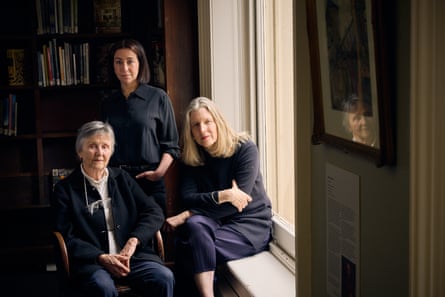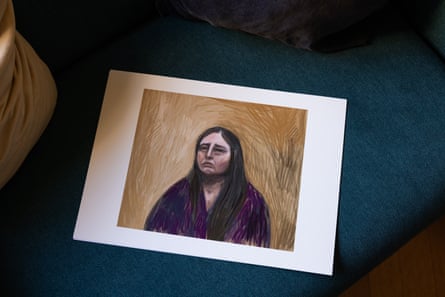“None of us wants to write about this. And none of us wants to not write about it.”
The profound inner conflict of the three narrators begins on page two of The Mushroom Tapes and never quite resolves, lingering as an ethical tension that colours almost every page.
Four months on from the guilty verdict, Helen Garner, Chloe Hooper and Sarah Krasnostein, three of Australia’s most acclaimed writers, appear to have made their peace with the queasy ambivalence that plagued them while covering the Erin Patterson case; an ambivalence that was not shared by the global media as it covered the sensational 10-week trial.
Have we all reached saturation point by now? Have we devoured enough of the tale about a dish wonderfully described in The Mushroom Tapes as the “flamboyantly retro” beef wellington? The elusive food dehydrator? The fake cancer? The fake cat? Here we are, still turning the page, still clicking the headlines, still asking: what was she thinking?
Speaking to Guardian Australia, Garner, Hooper and Krasnostein continue to dissect and digest the case. As Krasnostein puts it, “There’s still daylight between the puzzle pieces.”
“At first, we were seriously considering that this might have been a great injustice … not in terms of total innocence, but we were open that maybe it wasn’t quite what it looked like, and maybe there was some explanation for this behaviour,” she says. “And then I think, as the trial progressed, it became more and more clear that this was perhaps far less complex than we had imagined. And also, I think, complex in other ways that we hadn’t anticipated.”

While covering another criminal trial that transfixed the world six decades earlier, philosopher Hannah Arendt famously coined the chilling phrase “the banality of evil”. There was no grand passion, no financial ruin, no clear revenge plot behind the Patterson murders; only a series of petty lies, poor choices and escalating deceptions. Ultimately, Hooper concludes, Patterson’s decision to poison four members of her estranged husband’s family wasn’t driven by coherent motive but the friction of ordinary life – a kind of mundane, self-absorbed indifference, far more difficult to comprehend than outright malice. The banality of evil indeed.
The unconventional and collaborative structure of The Mushroom Tapes coalesced from the logistical and ethical complexity of covering the trial, the trio tell Guardian Australia. The book is not a traditional narrative account but is composed primarily of edited transcripts of recorded face-to-face and phone conversations and emails exchanged between Garner, Hooper and Krasnostein.
They worked from a staggering amount of raw material: their final 50,000-word book was a heavily edited version of 265,000 words of recorded conversations. The authors came to an agreement about the transcripts early on.

“There was a rule that was stringently enforced, about not putting too much lipstick on things that were said spontaneously,” Krasnostein says.
Too much polishing, adds Hooper, would have compromised the authenticity and the natural flow of the women’s discussions.
The project began as a road trip, a literary iteration of a feminist road movie that inevitably led to bouts of humour – observational, ironic, absurdist but invariably dark in hue – along the way. Their thoughts and reflections, recorded immediately after leaving the courtroom or media overflow room, and on the two-and-a-half hour road trips from Melbourne to Morwell, captured a raw, unfiltered response to the evidence.
Garner, the most famous of the three for covering trials, admits she was not at first “burning” to cover this one. And yet, at some point, a phrase from Janet Malcolm’s The Journalist and the Murderer crept into her head.
“‘The familiar stirrings of reportorial desire’, I think is the phrase,” she says. “Just that thought, a little itch you get when you think ‘maybe I am interested in this after all’.”

The idea of doing it with two younger women with whom she shared a friendship appealed to her. Relegated to the back seat in the car, Garner’s quirky, observational notes at times border on the delightfully absurd. “Look at that banksia bush,” she insists, in the middle of a tense encounter with an ominous looking black SUV with tinted windows that silently creeps up behind the women while they park outside Patterson’s desolate house. As they hightail it out of Leongatha, she is preoccupied with some nearby cattle on a hill: “What are those black ones called?”
Garner insists it was not her intention to subvert the gritty true crime tenor of their mission.
“It’s just I was in the nanna position in the car,” she says. “My whole life is just a matter of looking at things that don’t seem to have any meaning until you pick them up and put them somewhere.”
With its vividly described world – eternal fog, coal dust, pubs and motels (complete with sprouting mushrooms in the gardens) – Morwell almost becomes a character in the book. It is the backdrop to the authors’ almost nightly sessions in their motel, where they air their nagging concerns over what they are doing.
“Is our bearing witness actually more high-minded, or are we dressing up our own motives?” asks Hooper.
“I would hate to think I was just perving,” Garner retorts.

With the recurring evidence of poisoned food, foraging in the forest, the whole “witchiness” of it all, as Hooper describes it, the strong feminist leanings of all three writers are never far from the surface. The whole “Adam and Eve thing with the apple”, Krasnostein says, “the sorrow it contains … like Medea” – albeit one where the outraged woman slaughters her husband’s parents, not his kids.
The trio discuss the ways the media portrays women who kill; the contrast between the “grizzled and broken” male crime journalists and their highly maintained young female counterparts (do they smile so much to prove they are defanged, Hooper muses); and the frustrations of intelligent women who are relegated to home-maker roles. In Erin’s case, where does all that “unused intellectual energy” go? Either “a weird sense of superiority”, Krasnostein suggests, “or researching the hell out of mushrooms”.
As the trial stretches well beyond the initially predicted five weeks, the women come to the grim realisation there is the possibility of a hung jury, or even a not-guilty verdict, given almost all of the evidence is circumstantial. In the book, Garner warns her co-writers she is unwilling to endure a retrial; since the book was written, Patterson is now appealing against her convictions, maintaining she is innocent and that the deaths were a terrible accident.
“The idea that this gruelling life that we were living was going to go on and on and on, with no end to it, that’s what my moment of panic was,” Garner says now.
“It was kind of unbearable, and there’s a lot of pain and fear and sadness and anxiety about whether you should be writing about it in the first place. And I’m thinking I’m too old, I can’t go back there. I can’t do this again.”
And the mind of Erin Patterson, behind a face that looked “out of a myth”, still remained “deep and unknowable” to Garner.
“There’s something about her that remains mysterious to me, and I think that will always be the case,” she says. “There are other murders I’ve written about where I felt that I was able to understand the person who had committed the crime, that I had some ability, some clue, about why they did it. What powerful pain in their life or frustration in their life might have led them to do this appalling thing.
“But I find that very hard with Erin Patterson. I never reached that point with her and I don’t think I ever will.”
-
The Mushroom Tapes by Helen Garner, Sarah Krasnostein and Chloe Hooper is out in Australia on 11 November (Text Publishing, $36.99) and will be published in the UK on 20 November (W&N, £20)

 3 weeks ago
20
3 weeks ago
20

















































